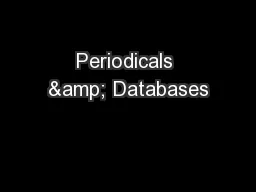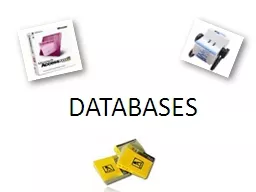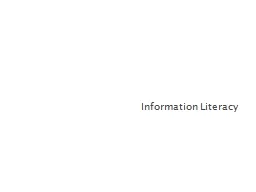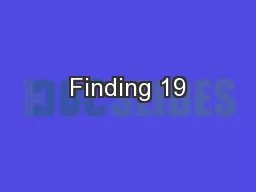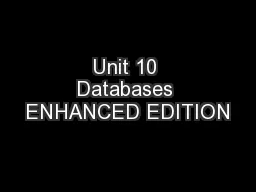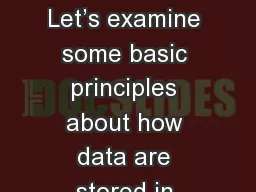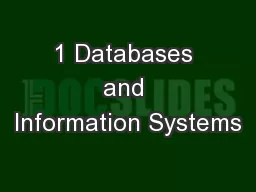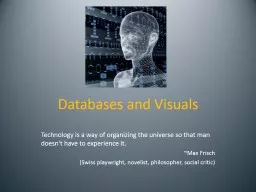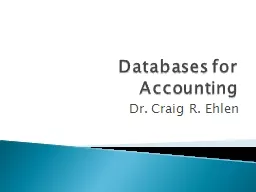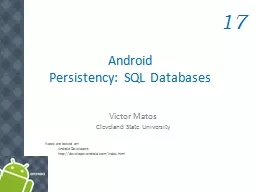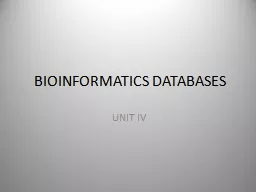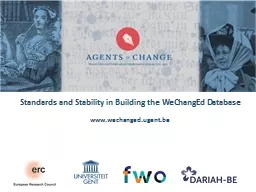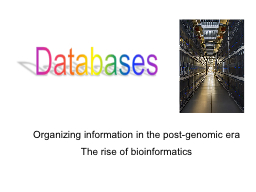PPT-Periodicals & Databases
Author : tatiana-dople | Published Date : 2016-06-15
Frederic Murray Assistant Professor MLIS University of British Columbia BA Political Science University of Iowa Instructional Services Librarian Al Harris Library
Presentation Embed Code
Download Presentation
Download Presentation The PPT/PDF document "Periodicals & Databases" is the property of its rightful owner. Permission is granted to download and print the materials on this website for personal, non-commercial use only, and to display it on your personal computer provided you do not modify the materials and that you retain all copyright notices contained in the materials. By downloading content from our website, you accept the terms of this agreement.
Periodicals & Databases: Transcript
Frederic Murray Assistant Professor MLIS University of British Columbia BA Political Science University of Iowa Instructional Services Librarian Al Harris Library fredericmurrayswosuedu. Jane Long. MLIS, University of Oklahoma. MA, Wright State University. Reference Services Librarian. Al Harris Library . jane.long@swosu.edu. How do I get started?. 1. . Keywords. 2. Boolean Operators. DATABASES. What do you think the word Database means?. DEFINITION:. A database is a collection of data or. information which is stored in a . logical and . structured way. Paper Based Databases. Paper Based Databases. In a nutshell, information literacy is "the process of: accessing, evaluating, and using information to make decisions, solve problems, and/or acquire knowledge." . Source: Young, R. M., & Harmony, S. (1999). Working with faculty to design undergraduate information literacy programs: A how-to-do-it manual for librarians. New York: Neal-Schulman.. th. century literary reviews. Knowledge Base. Library. The Library gives you access to online databases that you can use to identify and view 19. th. century literary reviews.. This enables you to find contemporary review material for authors such as Charles Dickens and Arthur Conan Doyle.. What are databases?. Databases are a collection tables that are searchable. These databases are filled with periodical materials (newspapers, journals, magazines, and even blog posts). These databases prevent you from having to go from journal to journal by hand. Unit Contents. Section A: Database Basics. Section B: Database Tools. Section C: Database Design. Section D: SQL. Section E: Big Data. Unit 10: Databases. 2. Section A: Database Basics . Operational and Analytical Databases. An . entity. is anything about which the organization wishes to store data. At your college or university, one entity would be the student.. STUDENTS. Student ID. Last Name. First Name. Phone Number. Life Without Databases: Lists. Lists are often sufficient for simple tasks. Not appropriate for complex information. Multiple lists lead to. Data redundancy. Data inconsistency. Duplicate data. Sorting issues . ~Max Frisch. (Swiss playwright, novelist, philosopher, social critic). Contents. Citing Databases. General Info. MLA. APA. Visuals—Internal Citations. MLA. APA. Visuals—Bibliographic Citations. MLA. Dr. Craig R. Ehlen . Database sources offer . quality, credibility, and reliability. . . . . Approved databases include . ABI/INFORM Complete. . , . ABI/INFORM Trade & Industry. , . Hoover's: Company Capsules & Profiles. 17. Victor Matos. Cleveland State University. Notes are based on: . Android Developers . http://developer.android.com/index.html. 2. 17. Android – SQL Databases. UNIT IV. DATABASE. A database is a . computarised. library used to store and organize data in such a way that information can be retrieved easily via a variety of search criteria.. The development of databases to handle the vast amount of molecular biological data is a fundamental task of bioinformatics.. WeChangEd. Database. www.wechanged.ugent.be. “The archive—whether manuscript, print, or digital—has never been objective or neutral. . […] [W]e . must attend to the unique ways that database technologies insinuate false ideas of completeness. era. The rise of bioinformatics. An information explosion!. Bioinformatics. Computational tools are developed to collect, organize and analyze a wide variety of biological data. Advances in DNA sequencing technologies have accelerated the pace of discovery. Much of the process is now automated. .
Download Document
Here is the link to download the presentation.
"Periodicals & Databases"The content belongs to its owner. You may download and print it for personal use, without modification, and keep all copyright notices. By downloading, you agree to these terms.
Related Documents

